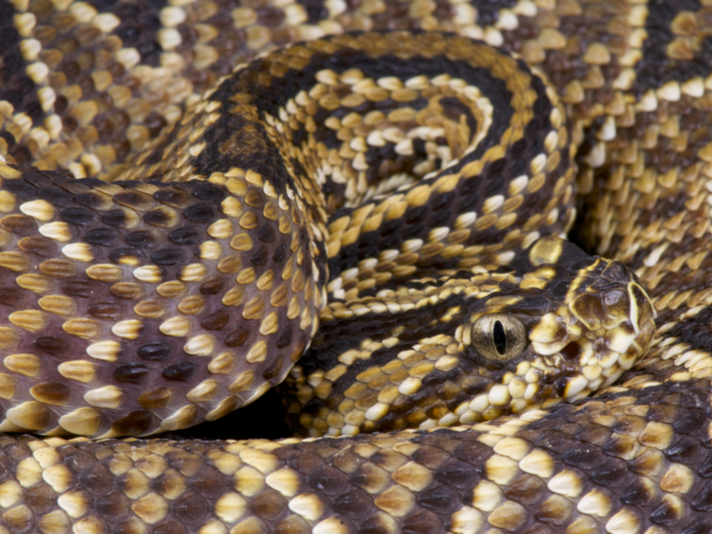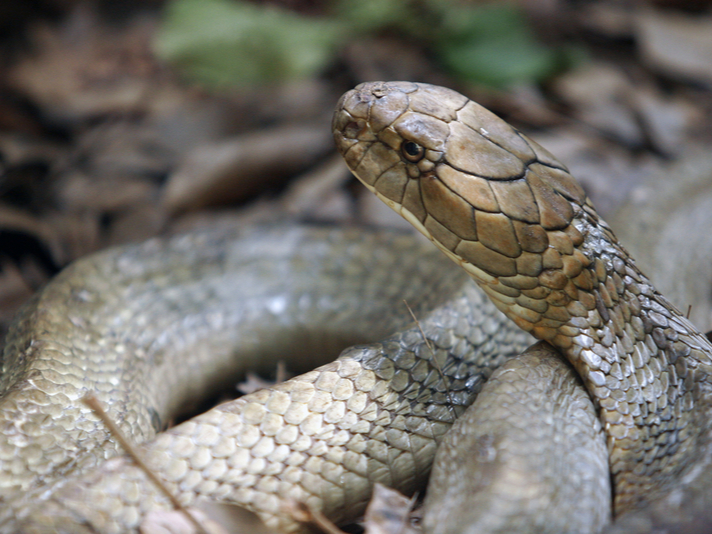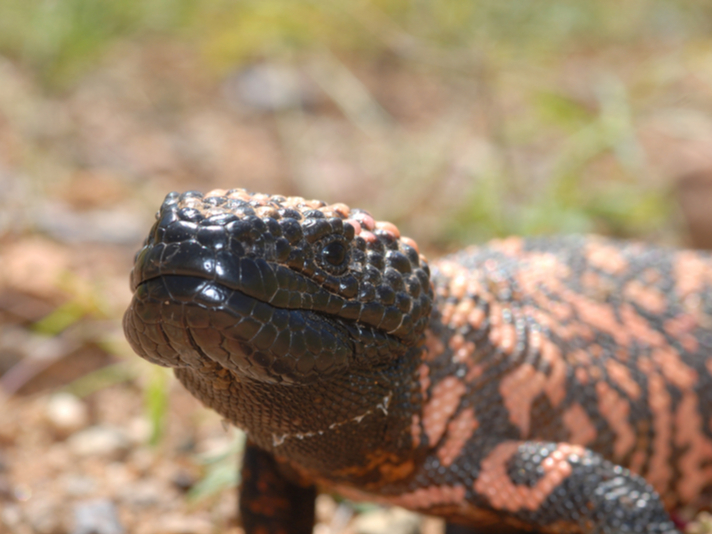The natural world continues to be the major source of therapeutic leads, with a number of promising new reptile and amphibian-derived medications close to being approved.
Over the past 50 years, pharmaceuticals have dramatically increased human life expectancy around the world, and medications derived from reptile and amphibian-produced compounds account for saving or extending the lives of countless individuals.

Tacio Philip Sansonovski/Shutterstock
The Brazilian pit viper, or jararaca (Bothrops jararaca), was instrumental in pioneering work on the use of venom in drug development and discovery.
With the identification of functional biochemical substances resulting from herps, substantial advances in medical herpetology are being realized. A variety of toxins, which may kill humans, when altered, are proving to be beneficial by destroying viruses, bacteria, parasites and tumors. Additionally, painkiller (analgesic), contraceptive, hypertension treatment, cholesterol-lowering, fever reduction (antipyretic), and wound-healing properties have been discovered in chemicals formed by reptiles and amphibians.
Reptile venom and amphibian poison are highly evolved, extremely complicated substances. Polypeptides are organic polymers composed of 10 or more amino acids linked by peptide bonds, forming part of (or the whole of) a protein molecule. The highly specialized polypeptides found in various reptiles and amphibians are the source for the development of a variety of pharmaceuticals.
Snake Venom Research
Snake venoms are highly modified saliva, comprised of hundreds of different types of peptides, enzymes and toxins, and they were used to treat arthritis and gastrointestinal problems as early as the seventh century B.C. Advanced technology—including DNA analysis; high-throughput RNA sequencing; reversed-phase, high-performance liquid chromatography and transcriptome-directed mass spectrometry—has provided the means for researchers to synthesize specific toxins within the venom. With this information, scientists can recreate the material and perform in-depth research regarding the functions of venom amino acid sequences.

reptiles4all/shutterstock
The venom of the South American rattlesnake (Crotalus durissus terrificus) has been shown to kill cancer cells in pancreatic and lung cancer patients..
The Brazilian pit viper, or jararaca (Bothrops jararaca), inhabits southern Brazil, northern Argentina and northeastern Paraguay. This species was instrumental in pioneering work on the use of venom in drug development and discovery. Researchers found the venom of the jararaca to contain a peptide that caused a severe drop in blood pressure in mice. The venom was subsequently used to develop the first angiotensin-converting enzyme (ACE) inhibitors, used to treat people with hypertension and congestive heart failure.
The ACE gene provides instructions for manufacturing the angiotensin-converting enzyme, which converts angiotensin I to angiotensin II. This enzyme is able to cleave polypeptides, resulting in the conversion. It is part of the renin-angiotensin system, which regulates blood pressure and the balance of fluids and salts in the body.
Capoten (captopril tablets), developed in the late 1960s from the venom of B. jararaca, is a mainstay of medical therapy for treating hypertension, congestive heart failure and chronic kidney disease. It is classified as an ACE inhibitor, which prevents the conversion of angiotension I to angiotensin II, resulting in vasodilation and decreased blood pressure. It has the shortest duration of the available drugs in its class, so it is sometimes used when patients are initially starting ACE inhibitor therapy. Captopril is also available in combination with a diuretic marketed under the name Capozide.
Hemocoagulase is an isolated and purified snake venom enzyme from the jararaca, as well as that of the fer-de-lance (B. atrox). The anti-hemorrhagic drug is used in all fields of medicine for the prevention and treatment of hemorrhages of various origins, including dental and surgical treatments.
Want To Learn More?
Snake Venom Shown To Reduce Cancer Tumors In Mice
Drug Derived From Gila Monster Saliva May Aid In Weight Loss
Ancrod (Viprinex) is a coagulant substance prepared from the venom of the Malayan pit viper (Calloselasma rhodostoma). Primarily used for the treatment of established deep vein thrombosis, the drug was marketed for several decades in Germany and Austria, until it was withdrawn in the 1980s. FDA approval for the use of ancrod in the United States is expected in the near future. Interestingly, venom composition varies between individual specimens. The venoms of more than 100 C. rhodostoma were analyzed; in all populations, females produced an intense protein band that was absent from all males, with significant ontogenetic (developing with age) variation. Additionally, geographic variation was found to influence venom composition. Studies of captive-bred specimens indicate that the intraspecific (existing within a single species) variation in venom is genetically inherited rather than environmentally induced.
Cobra venoms consist primarily of neurotoxins and are fast acting, quickly crippling the nervous system, which results in victim paralysis, respiratory failure and possible death. The king cobra (Ophiophagus hannah) possesses a unique protein called ohanin, which is made up of only 107 amino acids. By isolating specific parts of ohanin, the venom is detoxified, resulting in a new painkiller in pill form. The painkiller is 20 times more potent than morphine, with no side effects at dosages up to 2,000 times the effective dose.

phanawan/shutterstock
The king cobra (Ophiophagus hannah) possesses a unique protein called ohanin, which is made up of only 107 amino acids.
An additional painkiller derived from black mamba (Dendroaspis polylepis) venom is currently in development. In mice, the painkiller Mambalgin has been found far more effective than morphine, without the side effects. However, additional testing is required prior to determining its effectiveness in humans.
Several over-the-counter pain relief ointments and liquid liniments associated with snake venom are widely marketed. Cobroxin claims to include cobra venom, while Viprosal and Vipratox purportedly include the venom of various viper species. Although many testimonies of their effectiveness can be located, they are dubious at best.
Snake venoms are typically oversimplified by being classified as either neurotoxic (primarily found in elapids), which paralyzes the respiratory system; hemotoxic (primarily found in viperids), which causes necrosis (death of tissue); and anticoagulant (preventing the blood from clotting). However, various species possess venoms containing both neurotoxins and hemotoxins, with some continually evolving and altering their makeup.
A venomous snakebite can prove to be lethal; however, snake venom is also the source that saves the lives of many of the most serious snakebite victims. Venom is the foundation for antivenom (or antivenin), an intravenously administered, diluted, freeze-dried product derived from specific snake venoms. Antivenoms have been used successfully for more than a century and constitute the only truly effective treatment, administered to thousands of bite victims annually. Ongoing improvements, as well as a greater number of species-specific antivenoms, should present fewer adverse reactions and improved recovery results.
In 1886, working with six massasauga rattlesnakes (Sistrurus catenatus), Henry Sewall, a University of Michigan professor of physiology, and his student assistant, Fredrick Novy, began a series of experiments. The tests were completed in six months and provided the immunological foundation for the production of snakebite antiserums. The procedures pioneered by Sewall were also used to create the diphtheria antitoxin.
Lizards Helping Diabetics
Studies found Gila monster (Heloderma suspectum) venom stimulates the body’s production of insulin, a hormone that allows for utilization of blood sugar by cells, and prevents spikes in blood glucose levels, which can lead to damage of the heart, kidneys, eyes, liver and extremities. After investigating the composition and activity of Gila monster venom, a 39-amino acid peptide was isolated and designated exendid-4.

Rusty Dodson/Shutterstock
Studies found Gila monster (Heloderma suspectum) venom stimulates the body’s production of insulin.
Byetta (exenatide) is a treatment for those suffering from type 2 diabetes mellitus. The injectable medication activates the glucagon-like peptide (GLP-1) receptor, which increases insulin secretion. This drug, commonly referred to as “lizard spit,” is manufactured from the synthesized Gila monster peptide and was introduced to the market in 2005.
More recently, two additional drugs from the same synthesized Heloderma venom have been produced. Victoza (liraglutide) and Bydureon (exenatide) help combat diabetes. Byetta is injected twice daily, Victoza once a day, and Bydureon, the newest formulation, is injected once a week.
An additional benefit is that whereas insulin requires constant refrigeration, these medications can be stored at room temperature for 30 days after initial use.
Help From Within Amphibian Skin
In addition to discovering the brain chemical serotonin, the Italian pharmacologist Vittorio Erspamer (July 1909-October 1999) is attributed with realizing amphibians may hold the key to drug discovery. After his dog attacked a toad and became very ill, Erspamer began studying the poison secreted by glands in the skin of toads. He discovered the profusion of chemicals have clear effects on animal tissue. The majority of his career was then focused on studying the peptides produced in the glands of frog skin, and establishing that these peptides had nearly exact counterparts in the nervous system of mammals.

Kazakov Maksim/Shutterstock
During the 1940s, African clawed frogs (Xenopus laevis) were widely used in human pregnancy testing and sold in huge numbers to various laboratories.
Libraries of amphibian skin peptides are available for drug research purposes. Samples from amphibians are primarily collected in the field, with researchers carefully extracting the poison by electrically stimulating the tiny muscles in the amphibians’ glands. This causes the toxins to form on the surface of the skin, where it can then be removed and freeze dried. Supposedly, the procedure causes no harm to the amphibians.
The experimental Therapeutics Research Group at the School of Pharmacy, Queen’s University Belfast, uses a high-performance mass spectrometer to analyze peptides within amphibian poison. This ensures the peptide structure is 100-percent accurate, and the team can then produce identical synthetic replicates of the identified peptide and use these for further research, greatly reducing the need for live amphibian donors.
During the 1940s, African clawed frogs (Xenopus laevis) were widely used in human pregnancy testing and sold in huge numbers to various laboratories. Even when maintained in poor conditions, captive specimens thrived, and research personnel noted their wounds would heal even in excrement-contaminated water. This led to the discovery of the natural antibiotic properties of the frog’s skin peptides.
A family of peptides, labeled magainins, with broad-spectrum antimicrobial activity was isolated from the skin of the African clawed frog. Magainins are antifungal, antiparasitic and antiviral, and those in X. laevis skin are responsible for the frog’s rapid wound-healing ability. Xenopsin is the synthesized resultant product, and it used in the modulation of gastrointestinal functions.
Princeton University engineers have developed a sensor that may revolutionize how drugs and medical devices are tested for contamination. Researchers have found a way to attach Xenopus peptides to a small electronic chip that emits an electrical signal when exposed to harmful bacteria, including pathogenic E. coli and Salmonella.
Ceruletide (caerulein) is extracted from the skin of the White’s tree frog (Litoria caerulea) and stimulates gastric, biliary (bile-related) and pancreatic secretion, and certain smooth muscle. As such, it is used in paralytic ileus (obstruction of the intestine due to paralysis of the intestinal muscles), as well as a diagnostic aid in pancreatic malfunction.
The Australian red-eyed tree frog (L. chloris) inhabits coastal eastern Australian rainforests, from Queensland to New South Wales and as far north as Prosperine. Researchers at Vanderbilt University have discovered that compounds secreted by its skin have been found to destroy the human immunodeficiency virus (HIV) without harming healthy T-cells. The peptides that destroy the virus are the same as those of the White’s tree frog; however, L. chloris produces them in considerably greater quantities.
The tropical dart frogs that comprise the family Dendrobatidae account for some of the most toxic animals on Earth. The 2-inch-long golden poison dart frog (Phyllobates terribilis) possesses sufficient poison to kill 10 adult men. For hunting, indigenous people of Colombia use the frog’s powerful skin-secreted poison to tip their blowgun darts.
The phantasmal poison frog (Epibedobates tricolor) inhabits the rainforests of Ecuador, and, like its relatives, poison secreted by glands in its skin protects it from predators. Its poison is too toxic for use as a human painkiller but has proven to be two hundred times more effective in the suppression of pain than opium.
Epibatidine, derived from the poison, was artificially engendered into the less toxic ABT-594, or Tebanicline, a partial agonist at neuronal nicotinic acetylcholine receptors, resulting in a potent synthetic, non-opiod analgesic drug that affects nicotine receptors on nerve cells. The drug is non-addictive, does not impair breathing and seems to be effective for as long as it is used. It has the ability to suppress pain, including that of nerve damage that is typically impervious to opiates. Clinical trials are ongoing, with approval expected within the next few years.
In Conclusion
Significantly large numbers of mainstream pharmaceuticals originate from nature rather than from a chemist’s test tube. The natural world continues to be the major source of therapeutic leads, with a number of promising new reptile and amphibian-derived medications to combat serious, life-altering conditions—including stroke, diabetes, epilepsy, Alzheimer’s, cancer and serious microbial diseases—close to being approved. This especially holds true for drugs comprised of tropical frog peptides and the venom components of tropical snakes— yet another compelling reason to preserve critically endangered rain forests.
Dave Fogel authored the book Captive Husbandry and Propagation of the Boa Constrictors and Related Boas, and he has written numerous articles for various publications, including REPTILES, Reptiles USA, The Vivarium, Captive Breeding and Reptile and Amphibian Magazine. Jennifer Fogel earned a bachelor’s degree in biology from Thiel College and a Doctorate of Pharmacy from Lake Erie College of Osteopathic Medicine School of Pharmacy. She is currently employed as a pharmacist.
